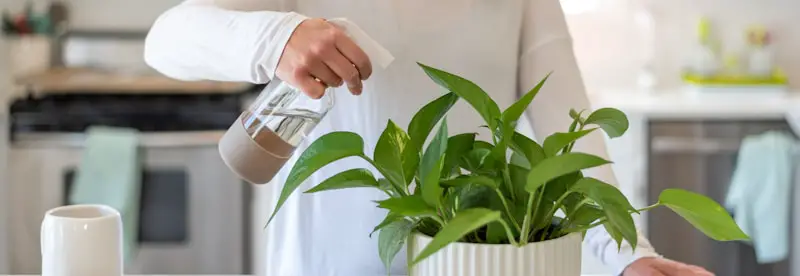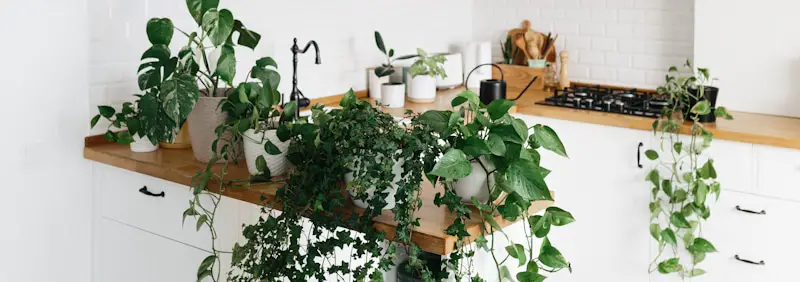Pothos plants require appropriate care to survive, and one of the most crucial aspects of plant care is watering. But how often should you water Pothos? Read more ahead to find the answer!
Generally, it would be best if you planned to water a Pothos plant at one or two-week intervals, contingent on the season and temp. Examine the soil to ensure it is dry before watering the plant, then add water until it begins to drain.
There’s more to watering Pothos than you’d think. We discuss how often you should water Pothos plants and the various factors that impact your plant’s watering requirements in this complete care guide.

Pothos Watering Care Guide
Watering a Pothos plant can be particularly challenging since it can thrive with minimal watering. That is why many houseplant owners forget to take proper care of them. If you neglect to water your Pothos plant properly, you can regret it. Below is a complete care guide for Pothos watering so that you can learn everything you need to know:
Water Quality
You can maintain a healthy Pothos plant with a pure water supply. The ideal water option is distilled, filtered, and rainwater. Another handy trick is to mix two teaspoons of 35% hydrogen peroxide for each gallon of water.
Water Amount
Various factors can affect watering, including:
- plant size
- amount of light exposure
- amount of water
- soil composition
- seasons
Watering Time
It is ideal for watering a Pothos plant at seven to ten-day intervals. It can help if you don’t have a fixed watering schedule. As an alternative, check for soil dryness and water the plant as soon as you see signs of burning. If you do, ensure that you water the Pothos adequately to immerse all the roots.
How Often Should You Water Pothos?
Keeping a Pothos plant healthy is feasible by watering it through feel without having a fixed schedule. Still, maintaining a watering routine can make check ups easier for your Pothos plant. So, how often should you water Pothos? The answer is complex, but a regular or weekly checkup schedule can make all the difference between a healthy and a sick Pothos plant.
The watering frequency relies on a broad range of influences, including the amount of light you provide and what type of dirt you use. The ideal strategy is to evaluate the time it takes the plant to dry out and make a schedule accordingly.
The Pothos plant prefers watering after its dirt dries out entirely, which can take a week in the summers, and some more weeks in the winters. During the hot seasons, you can use some all-purpose liquid plant fertilizer with each watering session.
How Can I Tell When My Pothos Plant Requires Water?
There are some signs to check for so you can tell when it’s time to water a Pothos plant. The dirt can feel dry when you touch it, and your pot becomes lightweight. The leaves, usually stiff and waxy with proper watering, look a bit floppy. They should spring up in a few hours once you water the plant.
Be aware that Pothos leaves can also wilt with overwatering — the drooping may be yellow or have black spotting. Sadly, you can’t revive leaves with overwatering damage. Note that a Pothos plant is generally more lenient with underwatering than overwatering.
How Long Should You Water Pothos?
How long you should take to water your Pothos relies on how sizable it is and what watering technique you utilize. A larger plant can take more time to water than a smaller one. If you pour water from the top, it can take less time than watering it from the bottom.
After water from the top, look for extra water in your pot or saucer. Throw out that excess water to avoid root rot. If watering the plant from the bottom, allow it to sit in a dish of water for around 15-20 minutes or when the soil surface feels constantly moist.
That latter technique prevents overwatering of the Pothos, but many plant enthusiasts also get by with watering from the top. Whichever method you use, ensure that your Pothos plant has adequate water.
Do Pothos Plants Like Misting?
If you wish to mist a Pothos plant, it might be since you want to increase the plant’s surrounding humidity. Pothos is tropical, so it prefers additional moisture. Still, it can tolerate some low humidity. You don’t have to mist it or get a humidifier, but you can try it if you stay in a dry climate.
Misting can also help aerial roots. With time, a Pothos plant grows broad aerial roots over the soil surface. If your Pothos plant has aerial roots growing up a stick, it can be beneficial to mist the plant’s base to aid them in climbing and absorbing some nutrients.
Misting is a subject of dispute in the plant enthusiast community. Some think it increases the humidity, while others believe it can disperse bacteria and pests without boosting the moisture. Try keeping your plant in a dish of wet stones as a humidity-booting alternative, or you can place a humidifier close to the plant.
Resistant to neglect as it might be, the Pothos plant ideally thrives with proper watering. Thankfully, the plant shows clear signs when it requires watering and commonly survives if underwater. With a fixed checkup schedule and some fertilizer as the plant matures, you can enjoy the Pothos plant’s abundant vines and leaves.
Pothos Watering Issues
Underwatering
A Pothos plant can curl as a way to preserve moisture if it gets little to no watering. Therefore, ensure that you water it at one or two-week intervals at the minimum.
It would be ideal for tracking the time it takes your Pothos plant’s dirt to dry up after each watering session and making a schedule. Like other indoor plants, Pothos require more water in the hotter seasons than the colder ones. So, ensure that you change your watering schedule as the climate changes.

Overwatering
Overwatering a Pothos plant can cause root decay and turn its leaves yellow. It also makes the soil soggy, so Pothos roots don’t thrive in the wet environment for too long.
You can prevent overwatering by keeping your Pothos plants in pots that have drainage holes. If there isn’t one, keep a drainage tray in your container. That allows extra water to drain quickly from the dirt before it reaches the roots.
The Saturation Method
These warnings about excess water might sound like saturating your Pothos’s pot is poor plant care. Still, one of the most significant errors a Pothos plant owner can make is to water adequately to immerse the top of its root ball. The saturation method can provide the whole root system with water without creating stagnant water.
- Ensure that the Pothos is in a pot two inches taller than the plant’s root ball, with suitable drainage holes.
- Ensure that the potting medium you utilize is porous with proper drainage.
- Add the water cautiously surrounding the base of the Pothos, circumventing any water on its leaves until you see water coming out of its drainage holes.
- Softly tilt the pot to remove any stagnant water from the soil surface.
- Allow the first inch of dirt to dry entirely before the next watering session. Bottom watering is also an excellent watering technique.
Final Words
The Pothos plant is an excellent indoor plant for beginners as it can withstand a broad spectrum of light exposure, watering schedules, and humidity concentrations. It’s also popular among professional gardeners since it matures quickly and has a beautiful aesthetic look. Either way, ensure that you don’t neglect them and keep watering as required! Happy gardening!
Victoria is the owner and main author of hobby plants. She loves spending her free time in her garden planting and taking care of her plants. Victoria hopes you enjoy the content here!
![How Often Should You Water Ferns? [COMPLETE CARE GUIDE] How Often Should You Water Ferns? [COMPLETE CARE GUIDE]](https://www.hobbyplants.com/wp-content/uploads/2022/08/how-often-to-water-ferns-300x158.jpg)
![How Often Do You Water A Snake Plant? [FIND OUT HERE] How Often Do You Water A Snake Plant? [FIND OUT HERE]](https://www.hobbyplants.com/wp-content/uploads/2022/07/how-often-do-you-water-a-snake-plant-1-300x158.jpg)
![How To Propagate Pothos? [COMPLETE BEGINNER'S GUIDE] How To Propagate Pothos? [COMPLETE BEGINNER'S GUIDE]](https://www.hobbyplants.com/wp-content/uploads/2022/07/how-to-propagate-pothos-300x158.jpg)
![How Do You Propagate a Money Tree? [COMPLETE GUIDE] How Do You Propagate a Money Tree? [COMPLETE GUIDE]](https://www.hobbyplants.com/wp-content/uploads/2022/06/how-to-propagate-money-tree-300x158.jpg)
![Polka Dot Plant Care? [Everything You Need To Know] Polka Dot Plant Care? [Everything You Need To Know]](https://www.hobbyplants.com/wp-content/uploads/2022/08/polka-dot-plant-care-300x158.jpg)

![How To Bottom Water Plants [MOST EFFECTIVE TECHNIQUES] How To Bottom Water Plants [MOST EFFECTIVE TECHNIQUES]](https://www.hobbyplants.com/wp-content/uploads/2022/07/how-to-bottom-water-plants-300x158.jpg)
![Mother Of Thousands Plant [Complete Plant Care Guide] Mother Of Thousands Plant [Complete Plant Care Guide]](https://www.hobbyplants.com/wp-content/uploads/2022/07/mother-of-thousands-plant-300x158.jpg)
![Can Snake Plants Live Outside? [COMPLETE CARE GUIDE] Can Snake Plants Live Outside? [COMPLETE CARE GUIDE]](https://www.hobbyplants.com/wp-content/uploads/2022/08/can-snake-plants-live-outside-300x158.jpg)
![Majesty Palm Plant Care: [Complete Beginner's Guide] Majesty Palm Plant Care: [Complete Beginner's Guide]](https://www.hobbyplants.com/wp-content/uploads/2022/08/majesty-palm-care-300x158.jpg)
![Exotic Angel Plant Care: [Complete Beginner's Guide] Exotic Angel Plant Care: [Complete Beginner's Guide]](https://www.hobbyplants.com/wp-content/uploads/2022/08/exotic-angel-plant-care-300x158.jpg)
![Do Coleus Like Sun Or Shade: [Complete Care Guide] Do Coleus Like Sun Or Shade: [Complete Care Guide]](https://www.hobbyplants.com/wp-content/uploads/2022/08/coleus-sun-or-shade-300x158.jpg)